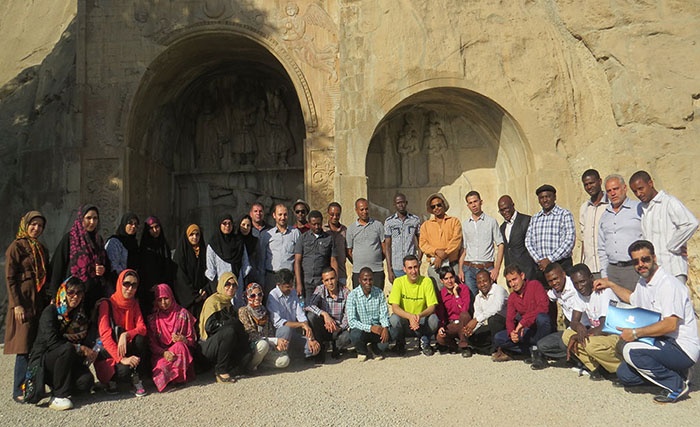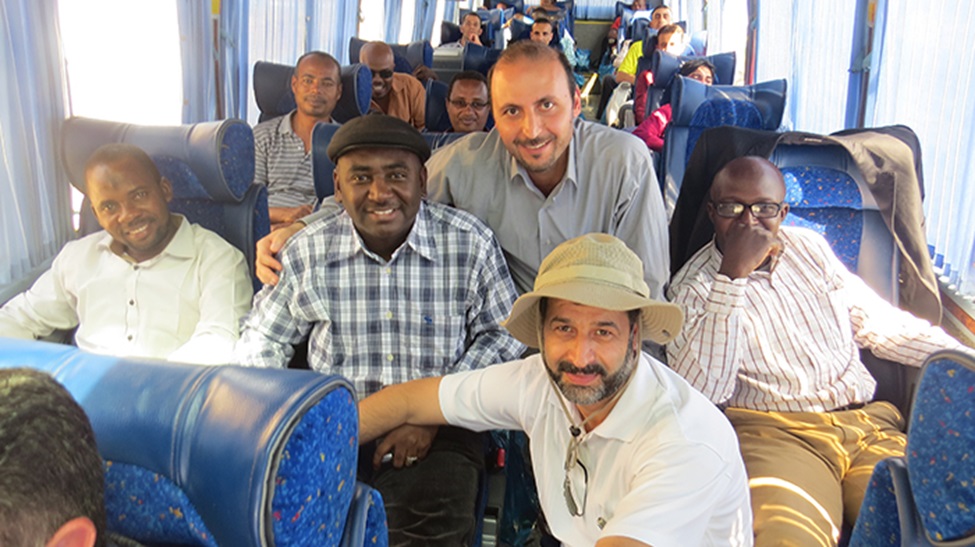TUMS International Students’ Trip to Hamadan & Kermanshah

The tour started early in the morning at 5:30 a.m., with the group heading first towards Hamadan. After a ride on the Saveh-Hamadan freeway, the group made its first stop for breakfast at Famenin, a town located approximately 20 Km from the city of Hamadan.

After breakfast, the journey continued, and, approximately two hours later, the tour entered the city of Lalejin in Hamadan Province. Lalejin is famous for its ceramic production, and it is known as a center for pottery production in the Middle East. In Lalejin, TUMS students visited various pottery shops. Upon students’ requests, the tour guide arranged a short visit to a pottery factory where students interacted with the workers to learn how these impressive pieces of handicraft take form.
Around midday, students were taken for lunch to a local restaurant where they were served with one of Iran’s iconic traditional cuisines, Ābgoosht – a Persian stew also known as Dizi (pronounced by pronouncing the letters D and Z). This dish is made of thoroughly cooked lamb and white beans, with boiled potatoes, fried onions, tomatoes and turmeric, and it is served with Doogh (a drink made with yogurt, water, salt, mint and other herbs). Soon after lunch, the students headed to Alisadr Hotel for an afternoon rest.
In the evening, TUMS students gathered in the hotel’s lobby and were briefed about the world’s largest water cave – Alisadr Cave, which was their next destination. This cave, approximately 11 Km long, is one of the most famous tourist attractions in Iran. Pedal boats are available inside the cave, and the entire tour went on a two-kilometer boat ride inside the cave’s waterway. The magnificent ceiling of the cave, with parts of it naturally formed into different shapes such as those of cauliflowers, needles and umbrellas, known by their scientific term of stalactite, will certainly amaze every visitor. Moreover, parts of the cave’s walls bore depictions of bows and arrows, suggesting the existence of this cave thousands of years ago as a habitat for primitive humans. After the visit to this incredible wonder of nature, the tour returned to the hotel for dinner and a good night’s sleep.

The following day, the journey to Kermanshah started with another bus ride, passing through various routes; the same routes trampled upon by the armies of great generals such as Alexander the Great or Persia’s own Darius in ages gone by. The tour first reached the ancient town of Bistoon, located 30 Km to the northwest of Kermanshah, which houses a magnificent statue of Heracles, carved in 150 B.C., showing the old tradition of immortalizing powerful historic figures during ancient times.

After having a delicious meal of Dandeh Kebab (the Persian name for grilled ribs) at one of the local restaurants in Kermanshah, the group once again returned to Bistoon’s mountains where they visited Taq-e Bostan (Garden’s Arch), a magnificent structure of rock reliefs, containing two arches carved on a mountain cliff. The Sassanid king chose this location for this structure, along with a large pool at the foot of the mountain, since it was located along the historic Silk Road and was thus a strategically important site. One of the arches, the larger of the two, dates back to the Sassanid period, evident by Darius’s inscription and the Parthian and Sassanid carvings. Two winged angels, symmetrically carved above the arch, symbolize the Persian army’s victory over Roman forces, with Ahura Mazda (the name for a higher spirit in the Zoroastrian religion) to the right and Mithras to the left. On the small arch, one sees the engraving of Shapur II (Shapur the Great) and his son, Shapur III, facing each other. Beside these figures, inscriptions written in Pahlavi translate as:
“This is the figure of Mazda-worshipping Lord Shapur, the king of kings of Iran and Aniran, whose race is from the Gods. Son of Mazda-worshipping Lord Hormizd, the king of kings of Iran and Aniran, whose race is from the Gods, grandson of Lord Nersi, the Shahanshah (king of kings).”
“This is the figure of Mazda-worshipping Lord Shapur, the king of kings of Iran and Aniran, whose race is from the Gods. Son of Mazda-worshipping Lord Shapur, the king of kings of Iran and Aniran, whose race is from the Gods, grandson of Lord Hormizd, the king of kings.”
Afterwards, students were taken to a guesthouse of Kermanshah University of Medical Sciences where they had time for a little R&R, and, later in the evening, they visited the local shopping center. Next morning, after breakfast, tour buses headed towards the temple of Anahita, located midway on the Hamadan-Kermanshah highway. Anahita, an iconic goddess in pre-Islam Iran, was a symbol of beauty, fertility, healing and wisdom, and was the protector of water. The temple is a rectangle building with its facade looking towards the south. The platform is higher than the ground, reachable by a staircase.
The trip wouldn’t have been complete without a visit to the tour’s next destination. Before heading back to Tehran, the group paid a visit to the mausoleum of the world-renowned scholar Ibn Sina, known as Avicenna in the West. This mausoleum, as the final resting place for one of the noblest and most accomplished scholars of the country’s entire history, was built over Ibn Sina’s tomb and contains a library, surmounted by a spindle-shaped tower with 12 pillars, depicting his scholarly commandments on 12 scientific subjects of his era. Next to Avicenna’s grave lies Abu Saeed, Ibn Sina’s great friend and fellow scholar. The Avicenna museum, situated inside the complex, includes an exhibition for ancient objects, an anthropology section and an exhibition for books written by Avicenna.

The tours final destination was Ganj Nameh Waterfall, located 5 Km west of Hamadan near Abbas Abad Valley, on the foothills of Alvand Mountains. Beside the waterfall, there are two inscriptions engraved in Old Persian, Babylonian and Elamite languages. People from later periods who did not understand Old Persian or Babylon languages assumed that they contained the guide to secret treasures, and hence they named these inscriptions Ganj-Nameh, which translates into The Treasure Book, which is where the waterfall gets its name. May years later, these texts were translated into English and Persian.
Students boarded the buses one last time and rode back to Tehran, passing again through a mixture of plain lands and mountains of Hamadan Province. With Persian music playing and students enjoying a little snack while chatting about their astonishing visit to the distant past, evening rolled out quietly and turned into night as the TUMS tour entered Tehran.


Your Comment :